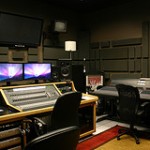Studio Tanning: Fool Your Brain? – Part 1
The reports of my death are greatly exaggerated. – Mark Twain
I’m jumping back in on my studio/broadcast/webcast mixing approach series. I’ve been wanting to write about today’s topic for months, but I held off because it’s hard to get at it without a bunch of setup which I’ll just warn you is what this post is going to be. This post is mainly a bunch of the stuff rolling around in my brain so I’m not sure how practical this part will be, although you guys are pretty smart so maybe you’ll connect some dots and see where I’m going. At any rate, I’ll try and get through this quick so that I can cut to the chase next time. Here goes.
So I’ve heard a lot of quotes from some big-time studio mixers lately talking about the demise of mono. But I don’t buy it. Mono is still here, and it’s not going anywhere, either. Mono just looks a little different than it did in the days before stereo. It’s incognito. That is, of course, unless you’re hearing music in places like restaurants, department stores, grocery stores, hallways, elevators, theme parks, etc, etc, etc, where there is a single speaker you’re hearing music through. Over the summer we were at a waterpark with the kids, and they had all these little, single speakers cranked all over the park. Mono all day long.
Plus, the reality is that most media released these days isn’t truly stereo. To achieve true stereo sounds must be captured in stereo using stereo mic techniques. Bruce Swedien comes to mind when I think about this because he is noted for recording records in true stereo. Most folks commonly think about stereo simply in terms of left-to-right imaging, however, using stereo mic techniques also captures space and depth of the sound source. In other words, stereo mic’ing captures left-to-right along with front-to-back and a sense of the space surrounding the sound. This can lend an almost 3D quality to a sound.
What we have in recordings today are generally mono sources that get panned left or right. You know, we take a mic and stick it on a guitar amp and pan it. Then we stick another mic on another sound and pan it the other way. That’s not really stereo. It’s more like dual-channel.
But I have a feeling the record buyer doesn’t really care if it’s surround, stereo or even mono – that’s just an audiophile thing. I mean, how many people even sit down in one spot to listen to a record? I don’t even do that myself. I’ll put on a record and I’ll be in the kitchen getting something to eat or just walking around doing something.
The problem with stereo and, in our case, stereo mixing is that in order for a listener to hear something the way it was intended, he needs to sit where the mixer was during the mixing process. However, it’s pretty rare for home listeners to even have stereo setup properly. It seems like people typically set their speakers wherever they have room for them after putting everything else in a room. Music becomes a background thing for a lot of people these days, and they can end up so far away from the speakers that the spread simply becomes mono to them for all intents and purposes. Think about laptop computers. Some people’s heads are wider than the laptop.
The other side to this is these days a lot of people are also listening through earbuds on their iPlayers, and headphones also seem to be seeing a bit of a resurgence. The problem here is that placing a speaker in each ear artificially spreads things out. Sometimes this can be very cool, but it can also do weird things to a mix sometimes. Cool or not, the music isn’t being listened to in the same fashion it was mixed in.
Now you might be thinking I have issues with stereo and these couple of posts are arguments against it especially if you remember the post I did about imaging expectations earlier this year. Before I go any further, let me just say that I love stereo. Surround formats like 5.1 are even better. Anything that can make the audio experience more immersive is wonderful.
However, what I’m trying to get at here is that maybe stereo isn’t as big of a deal as we think, and what we’ve been sold as stereo isn’t really what most of us think it is. And I’m not just talking about a consumer level thing. This goes all the way to the professional level and the gear we use everyday.
Think about those pan pots(or knobs) on our consoles. There is a general belief that when we have two speakers, a stereo image or space is created between the speakers allowing sounds to be perceived within that space. Now, the common thought amongst many engineers is that by turning the pan pot a sound can be moved or placed anywhere within the stereo image created by our two speakers. Sort of….but not really.
First off, think about what a pan pot is. It is simply a control that adjusts the amount of an input’s signal being sent to the left and right speakers. We turn the knob in one direction and the sound in the speaker on that side gets louder while getting quieter on the opposite side. If only our hearing perception were that simple, but, of course, it’s not. The way our brain actually perceives the location of a sound is incredibly complicated and utilizes things like time delay, reflection arrivals, and arrival angles. It’s not just a volume thing.
Dave Moulton actually has a great article about this and the stereo phantom image. Below is an excerpt where he discovered a bit of what really happens when we pan things:
Then, a little later still, I got into some loudspeaker research, and found myself called upon one day to make a research recording, wherein I recorded a batch of clicks with very carefully documented changes in level between the stereo channels. This was one of those cases where I figured I knew what was going to happen before I started. Given my golden ears, there just wasn’t much doubt that I could hear the image move as soon as I tweaked the pan-pot even a little, so I decided to calibrate the changes to 1/10th of a decibel, so that I’d be able to really pick out the subtle differences in localization that were going to happen when the levels between channels changed. However, I was very startled to discover that the phantom image didn’t seem to move at all even when the levels between channels changed a whole decibel! I was so startled that I became positive I had made a mistake when preparing the tape! A little investigation (well, about three hours, including chasing down all the wiring in the monitoring system!) showed me that I hadn’t made a mistake, and when the dust finally settled I had found out something quite interesting: that as long as the difference between channels is less than 3 decibels, the phantom image hovers pretty much in the middle point between the two speakers. I promptly ran this down to my buddies at the local loudspeaker factory and we tried it in the anechoic chamber with blindfolds and people pointing at the imaginary phantom, and it still remained true: with up to 3 dB difference between channels (that’s half-power, remember!) the image didn’t move much, maybe five degrees. With between 3 and 6 decibels difference in levels, the phantom quickly and without much stability migrated to the louder speaker, hovering just inboard of that speaker, and once the difference was greater than 7 decibels, the phantom was for all intents and purposes coming from the louder speaker.
So where does this leave us. Mono might not be dead after all and stereo might be a lie. Well, maybe stereo’s not a lie, but the two speaker thing and our gear might not work quite the way a lot of people think it does. And then it’s still questionable if the listening public even cares.
Next up I’m going to get into more practical applications and how I use this information when I’m mixing in a studio environment. In the meantime, I leave you with a video for your enjoyment. This was a promo for Bob Dylan rereleasing his catalog last year. Watch the video and then feel free to leave a comment on why you’d want to fool your brain.

 Previous Post
Previous Post Next Post
Next Post






Awesome Dylan video. Don’t do it, don’t fool your brain! The Dave Moulton article is really revealing. This supports (in the studio) mixing L, C, or R. Pan hard, or go home. But, I think there’s still room for just off center.
Headphones, cars, home theater, cinema, I’m sure there are other pretty common places that stereo is effective.
But, I mix in a distributed mono venue. Can’t do much about that!
Well, there are some tricks to get things to image off-center, but the pan knob alone doesn’t really do this.
If stereo is wrong, I don’t want to be right! love this video!